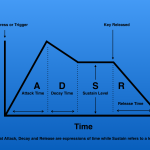Properties of Sound: Timbre
What is it that makes the sound of various instruments like guitars, flutes and pianos tonally unique from one another?
When the same note, let us take C4 for example is played on different instruments, how is it that the same fundamental pitch on each instrument is perceived as having a sonic characteristic of its own?
The answer lies in harmonics. Although each instrument has the same fundamental pitch, that of the note being played, each instrument has a unique set of overtones and undertones which give each sound it’s own character.
For a visual representation of the same we can pass the sound signal through a spectrum analyzer, which essentially breaks the sound into detailed fragments, much like a prism does to light.
The first example is that of an acoustic guitar playing the note C4 passed through the analyzer. As we see from the image, although the sound has a fundamental frequency of 526 Hz, the sound has a rich set of undertones and overtones that characterize the sound and give it its own timbre, essentially mapping out visually the sounds’ characteristics.
The second example is that of a grand piano playing the same note on the scale, it has the same fundamental frequency of 526 Hz but it has a unique set of undertones and overtones, which spell out its character. Even though the same note is played at the same pitch and at the same velocity, each sound has its own timbre, which is determined by its own set of harmonics as viewed under the spectrum analyzer.
Both the undertones and overtones for each sound are different in terms of how fast they decay away, their amplitude and even in minor pitch details. This is known as the sounds timbre, in the next article we’ll look at another important sonic identity, namely envelopes.




